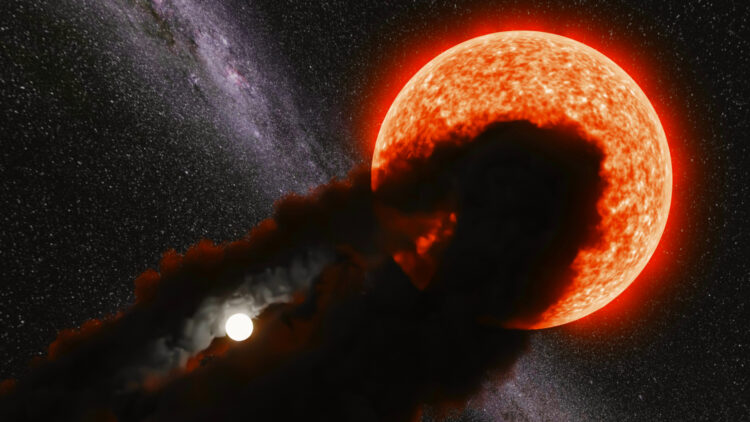
An enormous star blinked for seven years, and initially, nobody noticed. But then the European Space Agency's Gaia spacecraft saw the star, known as Gaia17bpp, suddenly spike in brightness — and years later, researchers think they finally know why.
The leading hypothesis is that Gaia17bpp, a red giant 55 times bigger than the sun, may be an example of an extremely rare binary star system whose light gets blocked by a small companion star surrounded by an enormous disk of dusty material that passes in front of the larger star every 100 or 1,000 years.
The goal of the Gaia spacecraft, which launched in 2013, is to stare at billions of stars, map their positions, and get extremely detailed information about their characteristics, including their brightness.
"While we were investigating [Gaia's] data set, we came across a very unusual star," Anastasios "Andy" Tzanidakis, an astrophysicist at the University of Washington, said during a news conference at the 241st meeting of the American Astronomical Society, held in Seattle this week.
The archival data showed that around 2017, Gaia17bpp, which had been just barely detectable, began to brighten over the course of about two and a half years, Tzanidakis said. "This was really remarkable," he added. "Stars typically do not do this."
Tzanidakis and his colleagues turned to other archives to see how the star had behaved in the past. They found records of Gaia17bpp stretching back to the 1950s. For most of that time, the red giant remained at the same unwavering brightness. "Then, around 2012, the star suddenly began to disappear," until it fully reappeared in 2019, Tzanidakis said.
The fact that this blinking behavior hadn't been seen in the archives going back more than 70 years suggests that such events take place on timescales of 100 — or even 1,000 — years, he added. "These eclipses are possibly once in a lifetime," Tzanidakis said. "We might never see it again."
Sign up for the Live Science daily newsletter now
Get the world’s most fascinating discoveries delivered straight to your inbox.
While the researchers still aren't sure what causes the dimming, they think a tiny companion star might be circling around Gaia17bpp. This companion may be surrounded by an elongated disk of dust that's larger than the average distance from Earth to the sun, the researchers said.
Tzanidakis connected the event to another mysterious star known as Epsilon Aurigae, a giant that undergoes two-year-long eclipses every 27 years, which also might be surrounded by a disk-bearing companion, Live Science's sister site Space.com previously reported.
Several other stars are known to have similar eclipsing events, but it's "still unclear what the connection is between all these systems," Tzanidakis said.
Gaia17bpp's behavior doesn't seem to be related to whatever is causing the bizarre flickering of the star KIC 8462852, also called Tabby's star or Boyajian's star, Tzanidakis told reporters at the conference. (Among other possible explanations for that star's mysterious flickering, some scientists proposed that the star might be surrounded by an alien megastructure.) Gaia17bpp's behavior is also unlike the famous dimming of the giant star Betelgeuse in 2019, he added.
Tzanidakis and his colleagues have many remaining questions about Gaia17bpp's blinking, such as whether it really is a disk causing the event and, if so, how the disk came to be and what it's made of. Because the behavior is so rare, it may take a while to unravel these mysteries. But for now, this is "the longest and deepest blinking event we've found in public data archives," Tzanidakis said.

Adam Mann is a freelance journalist with over a decade of experience, specializing in astronomy and physics stories. He has a bachelor's degree in astrophysics from UC Berkeley. His work has appeared in the New Yorker, New York Times, National Geographic, Wall Street Journal, Wired, Nature, Science, and many other places. He lives in Oakland, California, where he enjoys riding his bike.









